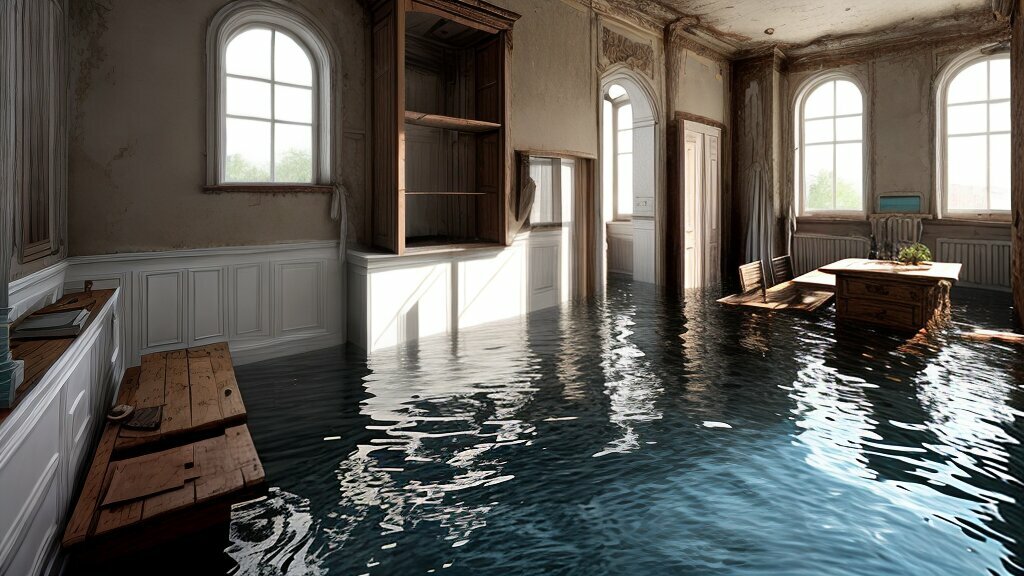Experiencing water damage in your property can be overwhelming and stressful, but taking immediate action is crucial to mitigate loss and initiate necessary repairs. Acting promptly can help safeguard your property and minimize further damage. In this guide, you will discover the crucial steps you should take immediately after experiencing water damage in your property.
Before taking any action, prioritize your safety. Assess the area for any potential hazards, such as electrical issues, structural instability, or contaminated water. If there are immediate risks, evacuate the premises and seek professional assistance.
Key Takeaways:
- Prioritize safety and assess the area for potential hazards before taking any further action
- If there are immediate risks, evacuate the premises and seek professional assistance
- Acting promptly can help safeguard your property and minimize further damage
- Assess which belongings are salvageable and clean them to prevent mold and bacterial growth
- Consult professionals if needed and contact your insurance company to begin the claims process
Assess the Safety of the Area
Experiencing water damage can be a stressful and overwhelming situation. However, it’s essential to prioritize your safety before taking any action. Assess the area for potential hazards such as electrical issues, structural instability, or contaminated water.
If there are immediate risks, evacuate the premises and seek professional assistance. Otherwise, you should proceed with caution, wearing protective gear like rubber gloves and waterproof boots, to minimize exposure to potential hazards and contaminants.
When assessing the area, keep an eye out for the following:
| Water Damage Safety Concerns | Assessing Risks | Property Hazards |
|---|---|---|
| Exposed electrical wires or outlets | Visible signs of structural damage, such as cracks in the walls or ceiling | Standing water or moisture on the floor |
| Contaminated water with sewage or toxic chemicals | Visible mold or mildew growth | Wet or sagging ceiling materials |
| Loose or damaged flooring | Water stains on walls or ceiling | Slippery surfaces or debris on the floor |
It’s crucial to assess the safety of the area before taking any action to prevent further damage or injuries. If you’re unsure about assessing any of these hazards, contact your local water damage restoration services for professional assistance.
Stop the Flow of Water
Once you have assessed the safety of the area, the next crucial step is to stop the flow of water to prevent further damage to your property. Water shut off is essential, so locate the main shut-off valve and turn it off immediately. This valve can typically be found near the water meter or where the main water line enters your home.
If you are unsure how to shut off the water, contact a plumber or your local water company for assistance. Remember, time is of the essence when dealing with water damage, so do not hesitate to take action.
In case of leaks, consider using a temporary fix such as a rubber patch or hose clamp, but keep in mind that this is only a temporary solution. Permanent repair or replacement of the damaged pipes is necessary to prevent future water damage.
Preventing further damage is crucial to minimizing repair costs and ensuring the safety of your property. Act swiftly to stop the flow of water and seek professional assistance, if needed.
Document the Damage
After ensuring your safety and stopping the flow of water, it’s critical to document the water damage for insurance purposes. Taking photographs or videos of the affected areas and any damaged belongings can help substantiate an insurance claim. Therefore, make sure to:
- Record water damage: capture the extent of the water damage and the areas affected accordingly;
- Document property damage: take photos or videos of any damaged belongings or items within the property. This includes furniture, appliances, electronics, personal belongings, and any other possessions that suffered water damage. Additionally, make a detailed inventory of items that have been impacted, including model numbers and values;
- Notify your insurer: inform your insurance company of the water damage as soon as possible. The sooner you report the damage, the quicker you will receive assistance.
By documenting the damage, you’ll have proof of the water damage, and it will help speed up the insurance claims process.
Remove Standing Water
Once you have assessed the safety of the area, the next step is to remove any standing water. This is a critical step in preventing further damage and potential mold growth. You can use buckets, mops, or wet vacuums to extract the water. Remember not to use electrical appliances in wet areas to avoid electrocution accidents.
If the volume of water is significant, it’s best to call professional water extraction services. They have the expertise and specialized equipment to remove water quickly and efficiently. This can speed up the drying process and prevent further damage to your property.
After removing excess water, you can focus on drying out the property. This can be achieved by opening windows, using fans and dehumidifiers to improve air circulation, and accelerate the drying process. Consider removing wet materials and furniture to aid drying and prevent further water damage.
Dry and Dehumidify the Area
After removing the standing water, it’s crucial to dry out the affected areas to prevent mold growth and further damage. Damp and humid environments are ideal for mold growth, which can cause health hazards. Open windows to allow fresh air to circulate and use fans to improve airflow. Consider using dehumidifiers to reduce the humidity level further.
To enhance the drying process, remove any wet materials, including furniture, curtains, and carpets. Saturating materials can retain moisture and become breeding grounds for mold and bacteria. Place the materials in a well-ventilated area to dry, preferably under a fan or in direct sunlight.
| Tip: | Humidity levels over 60% promote mold growth. Monitor humidity levels using a hygrometer and keep them below 50%. |
|---|---|
| Tip: | Remember to wear protective gear such as gloves, facemasks, and goggles while cleaning or moving water-damaged materials. |
If the water damage is extensive, consider employing professional water damage restoration services. They have specialized equipment such as air movers, dehumidifiers, and moisture meters to dry out your property faster and prevent further damage.
It’s critical to check moisture levels in hidden areas such as walls, ceiling, and floors. Moisture can seep into these spaces, causing rot, mold, and mildew. Use a moisture meter to detect moisture levels and tackle the issue immediately.
By taking these necessary steps to dry out your property, you can prevent further damage and ensure the safety of your home. Act fast and invest in proper equipment to restore your property swiftly.
Salvage and Clean Belongings
Assessing and salvaging your belongings after water damage is essential to minimize loss. Start by dividing items into categories:
- Salvageable: Items that can be cleaned and restored to their original condition.
- Questionable: Items that may be salvageable but require professional cleaning.
- Unsalvageable: Items that are beyond repair and need to be discarded.
Begin cleaning salvageable items by removing any surface dirt or debris. Wash hard surfaces with a disinfectant solution to prevent mold growth. For fabrics and upholstered furniture, consider professional cleaning services. Be sure to air dry all items thoroughly and monitor for any signs of mold growth.
| Item | Cleaning Method |
|---|---|
| Clothing | Washed in hot water with detergent and bleach (if safe for fabric) |
| Linens | Washed in hot water with detergent and bleach (if safe for fabric) |
| Books and paper products | Air dry and separate pages with wax paper |
| Carpets and rugs | Professional cleaning services recommended |
| Electronics | Do not turn on until professionally inspected and cleaned |
Remember, water damage can lead to mold growth and other health hazards, so take precautions to ensure your belongings are properly cleaned and disinfected. If in doubt, seek professional cleaning and restoration services.
Conclusion
Taking immediate action after water damage is crucial to minimize loss and begin the restoration process. By assessing safety, stopping the flow of water, documenting the damage, removing standing water, drying out the area, salvaging belongings, and cleaning, you can restore your property and prevent further damage. Remember to consult professionals if needed and contact your insurance company to begin the claims process. Act swiftly to safeguard your property and ensure prompt repairs.
FAQ
What should I do immediately after experiencing water damage?
Acting promptly is crucial. Follow the steps in this guide to mitigate loss and initiate necessary repairs.
How should I assess the safety of the area after water damage?
Before taking any action, prioritize your safety. Look for potential hazards like electrical issues, structural instability, or contaminated water. If there are immediate risks, evacuate the premises and seek professional assistance.
How can I stop the flow of water to prevent further damage?
If the water damage is caused by a burst pipe or other visible source, locate the main water shut-off valve and turn it off immediately. This will help prevent further damage to your property and belongings.
Why is it important to document the water damage?
Documenting the water damage is crucial for insurance purposes. Take photographs or videos of affected areas and damaged belongings. Make a detailed inventory of impacted items. This documentation will be useful for filing an insurance claim.
How do I remove standing water from my property?
Begin the cleanup process by using buckets, mops, or wet vacuums to remove any standing water. Avoid using electrical appliances in wet areas. If there is a significant volume of water, consider contacting professional water damage restoration services.
How can I dry and dehumidify the affected areas?
After removing standing water, open windows, use fans, and dehumidifiers to improve air circulation and speed up the drying process. If necessary, remove wet materials and furniture to facilitate drying.
What should I do to salvage and clean my belongings?
Assess which belongings are salvageable and begin the cleaning process. Items made of porous materials may need professional cleaning or replacement. Clean hard surfaces with disinfectants to prevent mold and bacterial growth.
Why is taking immediate action after water damage important?
Acting swiftly helps minimize loss and initiates the restoration process. By assessing safety, stopping the flow of water, documenting the damage, removing standing water, drying out the area, salvaging belongings, and cleaning, you can restore your property and prevent further damage. Consult professionals if needed and contact your insurance company to begin the claims process.









